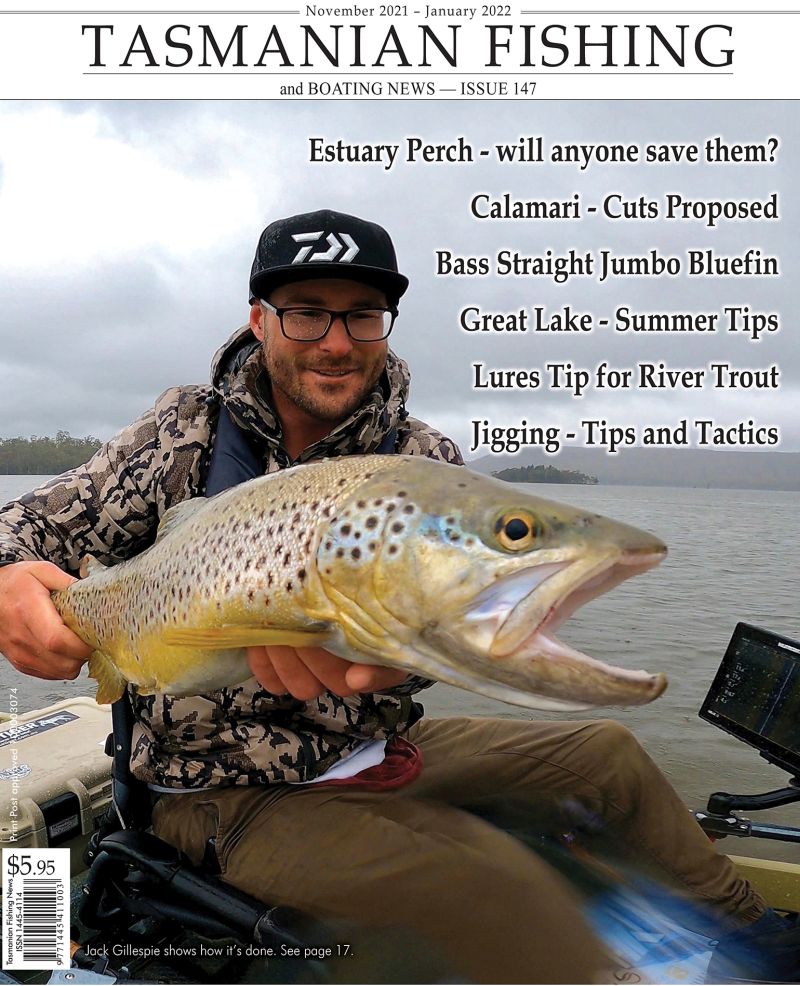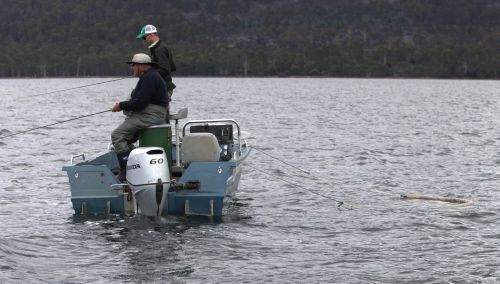From the Archives ...
Atlantic salmon the hard way
Atlantic salmon the hard way
Scott McDonald
The first Atlantic salmon eggs used to begin Tasmania's Atlantic salmon aquaculture industry were introduced into Tasmania in 1984. From these humble beginnings a valuable Tasmanian industry has evolved with a worldwide reputation for having a premium disease free product. This industry provides a spin off to all anglers in the form of regular escapes of salmon from the farms.
Tying an "Emu Squid"
by Richard Carter
The original Emu Squid fly was developed while I was working in Whyalla SA. Most of this work was with the millennium bug project for BHP's computer systems. The real reason was the great fishing in the area. Salmon, King George Whiting, Snapper, Yellowtail Kingfish and many other species - the only reason I took the job in the first place.
- Category: Fly Fishing
- Hits: 8776
Mayflies - the fly and the fishing
by Daniel Hackett
There's something about mayflies, something significant. To the flyfisher they are the epitome of flyfishing - predictably unpredictable mesmerising creatures reeking of mother nature. I think it could be the mayflies ephemeral nature that is so mesmerising, fleeting slivers of beauty, existing above the water's surface for only a matter of hours. They are an order of animal that was given the title Ephemeroptera, derived from the Latin for short lived. Looking at a small dun one day I realised that I was staring at a small living glimpse of prehistoric artwork and furthermore that I was the only person in the world who would ever see it. Perhaps this why they're so special?
- Category: Fly Fishing
- Hits: 9363
Mega Mullet on the fly
by Damon Sherriff
You might have read an article I wrote last year on monster sea mullet of the Tamar...well, this is the sequel to that story.This season, Steve Robinson and I put away the light spinning outfits and dusted the cobwebs off the fly-rods! We had both caught some impressive mullet of up to 4.5 kg last season on conventional tackle but this season was a race to who could catch the first supercharged mullet on the fly, maybe in the State!
- Category: Fly Fishing
- Hits: 8447
The Fun of Albacore on Fly
by John Orchard
When Ron Crowden from Georgetown rang to ask if I would like to have a trip out chasing tuna with Rocky Carosi I just couldn't resist the opportunity to test out the new entry level Driftwood salt water fly rod made by Blackridge. Rocky & his wife Angela run a charter operation out of St. Helens called Professional Charters and Rocky was confident that he could put us on to some Albacore without too much trouble, so the scene was set, weather permitting, to attempt my first ever tuna on fly.
- Category: Fly Fishing
- Hits: 5230
Squid on fly
by Rob Paxevanos.
Bushy is still after that elusive wild ten-pound trout on fly. Harrison and Cooper have been in front of the pack catching makos on the long wand. The lads from A River Somewhere have been chasing bonefish in trendy places.
- Category: Fly Fishing
- Hits: 5600
Fly Casting - Plane and Stance
by Peter Hayes
Casting Plane
Most beginner and intermediate casters do all of their casting with the rod tilted at an angle away from their body. I guess they're scared of being punctured by the fly and whipped by the line. They erroneously believe this angle will keep the fly and line away from them.
- Category: Fly Fishing
- Hits: 5844
Secret fly fishing techniques of an English champion
John Horsey showed the "locals" some new techniques that will fool plenty of our trout. John was intrigued by the very slow way Tasmanians "strike" after the take and once he slowed himself down he was able to hook many more fish.
John explained that even although our fish descended from English stock only 145 years ago they often behave very differently, but in just a few days he adjusted his methods very successfully.
- Category: Fly Fishing
- Hits: 14528
Read more: Secret fly fishing techniques of an English champion
Fly leaders - the vital connection
Leaders are the vital link between the fly line and fly. Neil Grose looks at their development, plus their different applications and requirements.
- Category: Fly Fishing
- Hits: 12636
Depth and retrieve
by David Higgins
Probably the most important tip I can give you when fly fishing with nymphs or wet flies is - which is pretty much all fly fishers can do this time of the year is: remember exactly how you were fishing at the moment a trout takes your fly and do it again!
- Category: Fly Fishing
- Hits: 5606
Bead flies with a difference - Bead "bulging" nymphs
by David Higgins
One of the greatest innovations to fly fishing and fly tying, particularly in recent times, is the use of "Bead Heads" nymphs.There is no doubt that bead head flies in their many forms catch fish. Over the years, a huge number of fascinating fly patterns have been developed.
- Category: Fly Fishing
- Hits: 8277
Read more: Bead flies with a difference - Bead bulging nymphs
Current TFBN
Click above for current issue content. The current issue of TFBN is extensive and topical. In Tackle Stores, Newsagents and by subscription.
Delivered to your door for $48 for 2 years (8 issues). To subscribe, send Mike $48 via www.paypal.com.au . (Basic instructions are here) The email is at Contact Us. Your address will be included from PayPal.
Or phone Mike with your c/c handy on 0418129949
Please ensure your details are correct, for Mike to organise delivery.
TFBN Newsletter Sign up Form
Why not submit an article ?
When you have finished for the day, why not have a brag about the ones that didn't get away! Send Mike an article on your fishing (Click here for contact details), and we'll get it published here. Have fun fishing - tasfish.com
Category Descriptions
Here is a list of all of the Article Categories. The number in Brackets, eg (13) is the number of articles. Click on Derwent River and all articles relating to the Derwent will be displayed in the central area.
Articles by Category
-
Rivers (3)
-
Saltwater and Estuary Fishing (149)
-
Kayak Fishing (34)
-
Lakes (1)
-
Great Lake (62)
-
Lake Leake (52)
-
Woods Lake (16)
-
Lake Augusta (11)
-
Huntsman Lake (13)
-
Lake Pedder and Gordon (10)
-
Lake Dulverton (5)
-
Lake Crescent (6)
-
Tooms Lake (10)
-
Lake Mackintosh (2)
-
Lake Barrington (5)
-
Little Lake (8)
-
Meadowbank Lake (5)
-
Lake King William (7)
-
Lake St Clair (2)
-
Western Lakes (12)
-
Arthurs Lake (35)
-
Lake Echo (7)
-
Four Springs (54)
-
Lake Sorell (7)
-
Lake Burbury (6)
-
Other Lakes (57)
-
Brushy Lagoon (18)
-
Little Pine Lagoon (5)
-
Penstock Lagoon (16)
-
Brumbys Creek (7)
-
-
Events (48)
-
Estuary Fishing (0)
-
Coastal Catches (46)
-
Super Trawler (46)
-
IFS, DPIPWE, MAST and Peak Bodies (435)
-
Commercial Interests (98)
-
Other (24)
-
TFBN Back Issues (8)
-
Fly Fishing (67)
-
Trout Fishing (250)
-
Meteorology and Weather (8)
-
Jan’s Flies (50)
-
Tuna Fishing and other Game Fishing (86)
-
Cooking Fish (19)
-
Fishing Information (1)
-
Fishing Books (8)
-
Videos (5)
-
Tackle, Boats and other Equipment (146)
-
World Fly Fishing Championship 2019 (2)
Popular Tags
windyty.com
Visit https://www.windyty.com/
Rubicon Web and Technology Training
Hello everyone, I thought it would be a good time to introduce myself.
My name is Stephen Smith and I have been managing the website tasfish.com since May 2009.
It has been an epic journey of learning and discovery and I am indebted to Mike Stevens for his help, support and patience.
I am developing a new venture Rubicon Web and Technology Training ( www.rwtt.com.au ). The focus is two part, to develop websites for individuals and small business and to train people to effectively use technology in their everyday lives.
Please contact me via www.rwtt.com.au/contact-me/ for further information - Stephen Smith.
From the Archives ... (last chance)
Early season - Bob McKinley
Presented from Issue 105, August 2013
Bob is a professional fishing guide and guides for trout and estuary species. Check him out at www.fishwildtasmania.com
There are several things we look for in our early season trout waters. It is still winter and cold, so some of the things to consider are: Altitude as this dictates the water temperature and therefore feeding activity. Food for the fish. Availability of trout food is generally dictated by the quantity and quality of weed beds.
Quantity of fish.
Three waters which I believe fit all three requirements are:
Read more ...


